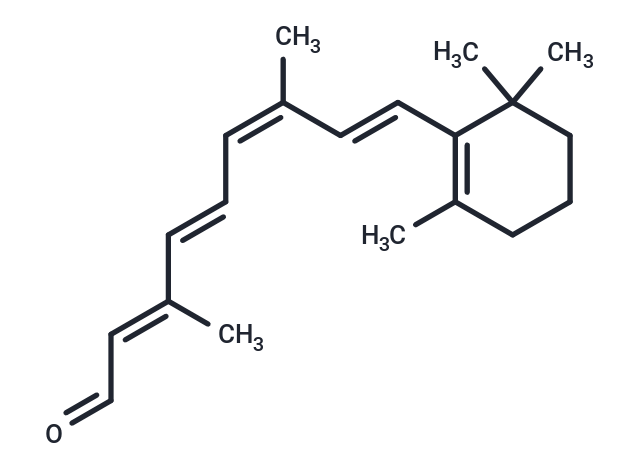Shopping Cart
Remove All Your shopping cart is currently empty
Your shopping cart is currently empty
9-cis-Retinal is a retinoid with Kd of 8 nM and 5 nM for cellular retinol binding protein-I (CRBP-1) and CRBP-II, respectively. 9-cis-Retinal accelerates the differentiation and maturation of rod photoreceptors in retinal organoids, reduces the toxicity of unliganded opsins, and can be used to study congenital stationary night blindness caused by G90D rhodopsin.

| Pack Size | Price | USA Warehouse | Global Warehouse | Quantity |
|---|---|---|---|---|
| 1 mg | $89 | - | In Stock |
| Description | 9-cis-Retinal is a retinoid with Kd of 8 nM and 5 nM for cellular retinol binding protein-I (CRBP-1) and CRBP-II, respectively. 9-cis-Retinal accelerates the differentiation and maturation of rod photoreceptors in retinal organoids, reduces the toxicity of unliganded opsins, and can be used to study congenital stationary night blindness caused by G90D rhodopsin. |
| In vitro | b>METHODS: The binding of 9-cis-retinol, 9-cis-retinal, and 9-cis-RA to CRBPI and CRBPII was monitored through fluorescence spectroscopy, and the data were analyzed using nonlinear regression to determine the apparent dissociation constant K'(d) . RESULTS: CRBPI and CRBPII bind to 9-cis-retinol (K'(d), 11nM and 68nM) and 9-cis-retinal (K'(d), 8nM and 5nM) respectively with high affinity; CRBPI or CRBPII have not been observed yet. Significant binding of CRBPII to 9-cis-RA. [1] |
| In vivo | b>METHODS: After recording baseline ERG, IRBP-deficient mice were allowed to rest for 12 hours, and 0.375 mg of 9-cis-retinal was injected intraperitoneally. ERG before and after were analyzed to test 11-cis-retinal in cones of IRBP-deficient mice. retinal defects. RESULTS: 9-cis-retinal treatment significantly increased cone photoreceptor responses; the cones of IRBP-deficient mice were particularly sensitive to exogenous 9-cis-retinal, and the recovery of cone photoreceptor function to WT levels indicated that IRBP deletion had minimal Cone dysfunction in mice is caused by 11-cis-retinal deficiency. [4] |
| Molecular Weight | 284.44 |
| Formula | C20H28O |
| Cas No. | 514-85-2 |
| Smiles | C(=C/C(=C\C=C\C(=C\C=O)\C)/C)\C=1C(C)(C)CCCC1C |
| Relative Density. | 1.31g/cm3 |
| Color | Brown |
| Appearance | Solid |
| Storage | keep away from direct sunlight,store at low temperature | Powder: -20°C for 3 years | In solvent: -80°C for 1 year | Shipping with blue ice/Shipping at ambient temperature. | |||||||||||||||||||||||||
| Solubility Information | DMSO: 10 mg/mL (35.16 mM), Sonication is recommended. | |||||||||||||||||||||||||
| In Vivo Formulation | 10% DMSO+90% Corn Oil: 1 mg/mL (3.52 mM), Sonication is recommeded. Please add the solvents sequentially, clarifying the solution as much as possible before adding the next one. Dissolve by heating and/or sonication if necessary. Working solution is recommended to be prepared and used immediately. The formulation provided above is for reference purposes only. In vivo formulations may vary and should be modified based on specific experimental conditions. | |||||||||||||||||||||||||
Solution Preparation Table | ||||||||||||||||||||||||||
DMSO
| ||||||||||||||||||||||||||
| Size | Quantity | Unit Price | Amount | Operation |
|---|

Copyright © 2015-2025 TargetMol Chemicals Inc. All Rights Reserved.